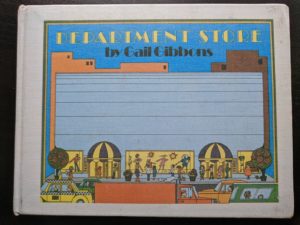Decided to devote a full work-week’s coverage to kid’s books, since it looks like I’m on an unintentional roll!
 My mother-in-law lives in the Virginia mountains, and is a longstanding frequenter/supporter of her local library. She also loves their library book sales, and brings bundles up to us in Maryland, primarily of books for the kids (since Heaven knows, I do not need more books!) I was poking around in my eldest son’s room the other day, trying to help him find his scattered Diary Of A Wimpy Kid novels, when I came across this volume. It was pretty unusual for me in that it had the full color cover illustration stamped on its hard binding. Most of the hard covers I’ve encountered usually limit themselves to a single contrast color with the background, but this book was published in the 1980s, so perhaps that accounts for it (plus, I’m pretty sure it never came with a slip cover, given the library stampings and lack of tape marks.) Drawn in by the cover, I paused my search for Jms’ other books and began to flip through.
My mother-in-law lives in the Virginia mountains, and is a longstanding frequenter/supporter of her local library. She also loves their library book sales, and brings bundles up to us in Maryland, primarily of books for the kids (since Heaven knows, I do not need more books!) I was poking around in my eldest son’s room the other day, trying to help him find his scattered Diary Of A Wimpy Kid novels, when I came across this volume. It was pretty unusual for me in that it had the full color cover illustration stamped on its hard binding. Most of the hard covers I’ve encountered usually limit themselves to a single contrast color with the background, but this book was published in the 1980s, so perhaps that accounts for it (plus, I’m pretty sure it never came with a slip cover, given the library stampings and lack of tape marks.) Drawn in by the cover, I paused my search for Jms’ other books and began to flip through.
Department Store is a fairly short book, a non-fiction depiction of the workings of your average department store, oddly reminiscent of the DK Discoveries series I’d devoured as a kid, tho the latter covered topics far further flung in history. To see that treatment granted to the department store in its heyday is like opening a wonderfully weird and layered time capsule here in 2020, not far removed enough to find department stores romantic as we watch them sink in real time to their grand dame ends, but close enough to remember when economies worked the way they’re depicted in this volume. The borrowing history of the book, which seemed to have been checked out several times a year on average from 1985-1991, till a last gasp in 1995 before it was weeded from circulation in 2013, follows that timeline, such that it feels odd to be holding this book now, like holding a wake for someone who isn’t dead yet.
Because this book is gorgeously illustrated in brightly colored line drawings with a strong mid-century modern influence, it feels like a celebration, not only of department stores but also of the epoch in which they thrived. Gail Gibbons peoples her store with customers and employees of every color, in a delightful utopia of shopping pleasure. I turned the pages, admiring the craftsmanship even as I wondered “who is this for?” The answer, I’ve concluded, isn’t just for the kids in the past who wanted to know more about the workings of their economy, but also for posterity, for the future and the curious children who will look back and wonder about structures like these, just as I once obsessed over the workings of castles and frontier towns. It feels strange to be reading this book now — and I’m not sure my kids would appreciate it either — but I’m looking forward to handing it to a curious grandchild several decades from now who wants to know more about the pre-Internet world.
